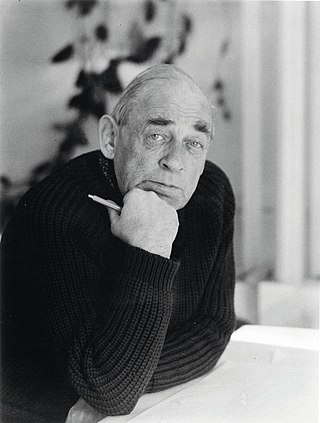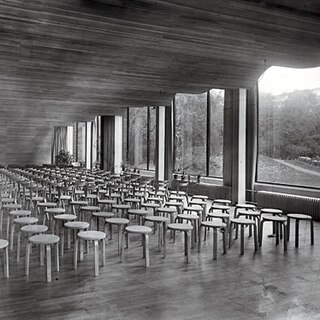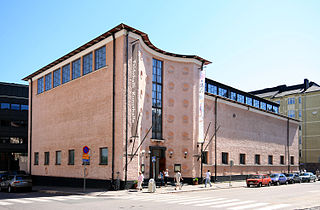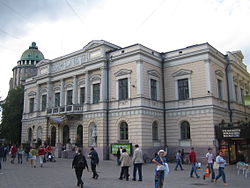
Hugo Alvar Henrik Aalto was a Finnish architect and designer. His work includes architecture, furniture, textiles and glassware, as well as sculptures and paintings. He never regarded himself as an artist, seeing painting and sculpture as "branches of the tree whose trunk is architecture." Aalto's early career ran in parallel with the rapid economic growth and industrialization of Finland during the first half of the 20th century. Many of his clients were industrialists, among them the Ahlström-Gullichsen family, who became his patrons. The span of his career, from the 1920s to the 1970s, is reflected in the styles of his work, ranging from Nordic Classicism of the early work, to a rational International Style Modernism during the 1930s to a more organic modernist style from the 1940s onwards.

Katajanokka is a neighbourhood of Helsinki, Finland, with around 4000 inhabitants in 2005. The district is located adjacent to the immediate downtown area, though in the first major town plan for Helsinki from the mid-18th century, the area fell outside the fortifications planned to encircle the city.

Helsinki Cathedral is the Finnish Evangelical Lutheran cathedral of the Diocese of Helsinki, located in the neighborhood of Kruununhaka in the centre of Helsinki, Finland, at the Senate Square. The church was originally built from 1830 to 1852 as a tribute to the Grand Duke of Finland, Emperor Nicholas I of Russia. It was also known as St Nicholas's Church until Finland declared its full independence in 1917. It is a major landmark of the city, and one of the most famous historical structures in Finland as a whole when viewed globally.

Artek is a Finnish furniture company. It was founded in December 1935 by architect Alvar Aalto and his wife Aino Aalto, visual arts promoter Maire Gullichsen and art historian Nils-Gustav Hahl. The founders chose a non-Finnish name: the neologism Artek was meant to manifest the desire to combine art and technology. This echoed a main idea of the International Style movement, especially the Bauhaus, to emphasize the technical expertise in production and quality of materials, instead of historical-based, eclectic or frivolous ornamentation.

Aarno Emil Ruusuvuori was a Finnish architect, professor and director of the Museum of Finnish Architecture. He studied at the Helsinki University of Technology, completing his studies in 1951.

Vyborg Library is a library in Vyborg, Russia, built during the time of Finnish sovereignty, before the Finnish city of Viipuri was annexed by the former USSR and its Finnish name was changed to Vyborg by the Soviet authorities.

Juha Ilmari Leiviskä was a Finnish architect and designer. He was especially known for his churches and other sacral buildings.
Kristian Valter Alexander Gullichsen was a Finnish architect. The son of Harry and Maire Gullichsen, he was born into a family of industrialists, designers and artists. His siblings were the renowned Finnish philosopher Lilli Alanen and Johan Gullichsen, a professor of engineering. Kristian Gullichsen had three sons and two daughters, one of the sons was the artist Alvar Gullichsen. Gullichsen was married twice; his second wife was architect Kirsi Gullichsen.

The architecture of Finland has a history spanning over 800 years, and while up until the modern era the architecture was highly influenced by Sweden, there were also influences from Germany and Russia. From the early 19th century onwards influences came directly from further afield: first when itinerant foreign architects took up positions in the country and then when the Finnish architect profession became established.

Arto Sipinen was a Finnish architect. He worked in the office of architects Alvar Aalto in 1959–61 and Viljo Revell in 1961–63. He founded his own architect's office in 1965. Sipinen has taught at Helsinki University of Technology Department of Architecture.

Rainer Mahlamäki is a Finnish architect, president of the Finnish Association of Architects (SAFA) from 2007 to 2011, Professor of Contemporary Architecture at the University of Oulu, and joint partner with Ilmari Lahdelma of the Helsinki-based architecture firm Lahdelma & Mahlamäki Architects, one of the most prolific such firms in Finland. A significant part of their work started as entries in architectural competitions, in which they have received 35 first prizes.
Mikael Sundman is a Finnish architect and writer. He wrote the polemical book Kenen Helsinki? (1970) together with Vilhelm Helander, and received the Eino Leino Prize in 1971.

Georg Hilding Ekelund was a Finnish architect, from 1950 to 1958 a professor of housing design at Helsinki University of Technology and from 1931 to 1934 editor-in-chief of the Finnish architects' journal Arkkitehti. His career as an architect spans the change in styles in Finland from the Nordic Classicism of the 1920s to the Modernism of the 1970s.
Jörg J. Kühn is a German architect and professor.
Malcolm Quantrill was a British architect, academic and architecture theorist. His best known books are The Environmental Memory – Man and Architecture in the Landscape of Ideas (1986) and Finnish Architecture and the Modernist Tradition (1998). He was a specialist in the history of the modern architecture of Finland. He was the first person to write critical monographs in any language on three individual Finnish modernist architects, Alvar Aalto – Alvar Aalto: A Critical Study (1983) – Reima Pietilä – Reima Pietilä: Architecture, Context, Modernism (1985) – and Juha Leiviskä – Juha Leiviska and the Continuity of Finnish Modern Architecture (2001). Already during his lifetime, he acquired a reputation for thorough and innovative scholarship in architecture, bringing a questioning attitude to well-known figures and canonical architectural history.

The Aalto House, the home of academician Alvar Aalto, is located in Munkkiniemi, Helsinki, Finland at 20, Riihitie. The house is part of the Alvar Aalto Museum, which functions in two cities, Jyväskylä and Helsinki. The other location in Helsinki where the museum functions is Studio Aalto, which is located ca. 450 metres from the house, at Tiilimäki 20.◇

Gustaf Nyström was a Finnish architect. Nyström has been described as one of the most important architects in Finland at the end of the 19th century and the beginning of the 20th century. He was active both as an influential teacher, as an architect in his own right, and as an official involved in groundbreaking urban planning projects.

Svenska normallyceum i Helsingfors (Norsen) was a Swedish school in the Kaartinkaupunki district of Helsinki between 1864 and 1977. The school was only for boys until 1974 when it became a co-educational school.















